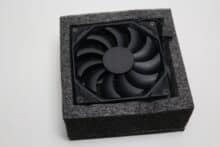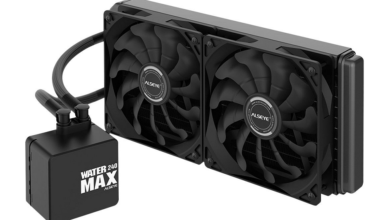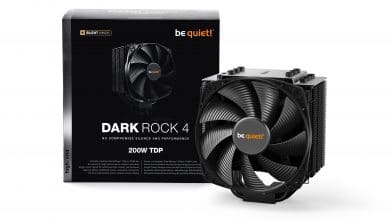
The manufacturer Alpenföhn (EKL AG) has long been a well-known manufacturer of CPU coolers and case fans. Alpenföhn always manages to attract attention, especially with the names of its products. Many coolers bear the names of well-known European mountains such as the Brocken. Now that the tower cooler line-up has received some updates, it is now the turn of the small form factor range. That’s why Alpenföhn unveiled the Alpenföhn Panorama 2 in November 2023 without much notice, which we are testing today.
The Alpenföhn Panorama 2 is a classic low-profile cooler and the successor to the Panorama 1, which has been in the manufacturer’s portfolio since 2009. The new features include a stylish, simple design with black coated radiator fins. The Panorama 2 is also very flat with an overall height of just 47 millimetres, making it particularly suitable for compact systems. The thin JetStream fan should also ensure efficient and quiet cooling. Alpenföhn charges a purchase price of € 39.90 * for the Panorama 2.
Alpenföhn Panorama 2 test: Technical details
General specifications
| Dimensions (with fan): | 94 x 47 x 93.5 mm (W x H x D) |
| Weight (with fan): | 350 g |
| Material: | Copper (heatpipes and base plate, nickel-plated), aluminium (cooling fins, black anodized) |
| Heatpipes: | 4x Ø 6 mm |
| Cooling capacity: | 95W |
| Compatibility AMD: | AM5, AM4 |
| Intel compatibility: | LGA,1700, LGA1200, LGA115x |
| Price: | € 39.90 * |
Fan specifications
| Fan designation: | Alpenföhn JetStream 92 |
| Bearing type: | Hydraulic-Dynamic-Bearing (HDB) |
| Dimensions: | 92 x 92 x 16 mm |
| Speed: | 500 – 3000 rpm |
| Noise level: | 30.6 db(A) |
| Delivery volume: | 80.3 m³/h |
| static pressure: | 3.75 mmH2O |
| Operating voltage: | 12 V |
| Voltage range: | 0,25 A |
| Power consumption: | 3 W |
| Connection: | 4-pin PWM |

Packaging & scope of delivery
As with previous products, Alpenföhn also packs the Panorama 2 in a very compact and inconspicuously designed cardboard box. This is printed predominantly in black and lists all the relevant technical data about the heat sink and the fan. All information is in English only. The packaging also features a few product images and technical drawings.
After opening the top flap, the first thing you see is a black box containing all the assembly materials and assembly instructions. All the necessary screws, brackets, spacers, thermal paste and a metal backplate are included. Underneath the box, wrapped in a block of soft foam, we find the Alpenföhn Panorama 2 with pre-assembled fan. The foam should easily protect the radiator body from damage and the manufacturer has also placed another protective film on the base plate.
Design & processing
Visually, the heatsink of the Panorama 2 fits seamlessly into the existing manufacturer portfolio and also has certain similarities with low-profile coolers from other manufacturers. With its dimensions of just 94 x 47 x 93.5 millimeters including the fan, the Panorama 2 has a very compact design and is therefore suitable for particularly small ITX systems. The total weight of 350 grams is comparable with the competition, taking the dimensions into account.
The heat sink consists of 52 vertical aluminium fins, which have been anodized black to improve their appearance. Heat is transferred from the CPU heatspreader to the fins via a nickel-plated copper base plate and four black anodized heatpipes, each with a diameter of six millimetres. To hide the ends of the heatpipes, Alpenföhn also places a black end plate on two sides. There is no manufacturer’s logo on the heat sink.
The pre-assembled fan from the JetStream series has a frame width of 92 millimeters and a frame depth of 16 millimeters. It is connected to the mainboard via a 4-pin PWM connector, allowing it to be operated in a speed range of 500 to 3000 revolutions per minute. The fan has also been designed in black or gray to match the heat sink. Alpenföhn has also provided the JetStream with small rubber buffers at the corners for decoupling.
The appearance and finish of our text copy are excellent. We found no processing or paint defects or other problems such as bent fins. Thanks to the RGB-less fan and the black coating of the heat sink, Alpenföhn has given the Panorama 2 a very neutral look. This means it should visually fit into almost any system without any problems.
Alpenföhn Panorama 2 test: Assembly
A test system mounted on a benchtable is used for the review. This allows us to rule out factors such as heat build-up in the housing. The test system consists of the following components.
- AMD Ryzen 5 1400 @ 3.8 GHz at 1.25V*
- ASUS TUF Gaming B550M-Plus*
- Crucial Ballistix Sport LT gray 32 GB DDR4-3000*
- Corsair Force Series MP510 960GB Nvme*
- Gigabyte AORUS GTX 1060 6G*
- LC-Power LC550 V2.31 Platinum Series 550W*
As with the Brocken 4, the Panorama 2 also uses the RockMount3 mounting system. This is a slightly advanced mounting solution based on the RockMount2 system. Alpenföhn continues to rely on a solid metal backplate (Intel) or the AMD retention module (AMD) and a bracket construction on the front for screwing on the cooler.
For our AM4 system, the front plastic brackets of the AMD retention module had to be removed first. Four plastic sleeves were then placed on the backplate, the new metal mounting brackets were fitted and screwed in place with four screws. Before the cooler can now be placed on the CPU, the thermal paste must of course not be forgotten. As always, we use Arctic MX-4 in our review and spread it evenly over the heatspreader.
As Alpenföhn supplies two sets of brackets for AMD, the Panorama 2 can be mounted in 90 degree increments. The CPU cooler is then placed on the CPU and the bracket already attached to the cooler is screwed to the mounting frame. Both screws are spring-loaded and can also be reached with the fan fitted. This saves time. Due to the compact dimensions, there are no compatibility problems with either the RAM or the VRM coolers.
Overall, the mounting system has been very well thought out and makes a solid impression. Installation is simple, requires no special tools and even the fan does not have to be removed during installation. The Intel backplate is also made of metal and looks very stable.
Volume and cooling performance
As already shown in the previous chapter, we use an AM4 system based on the Ryzen 5 1400 and the ASUS TUF Gaming B550M-Plus as test hardware. The Ryzen runs at 3.8 GHz at 1.175 V. To heat up the processor, it was loaded with Prime95 for 30 minutes. The temperature of the CPU was then read out with the CPUID hardware monitor. The room temperature was always around 20 °C during the measurements.
| wdt_ID | CPU-Kühler | Temperatur 50% PWM (in °C) | Temperatur 100% PWM (in °C) | Minimale Lüftergeschwindigkeit (in U/min) | Lüftergeschwindigkeit bei 50% PWM (in U/min) | Lüftergeschwindigkeit bei 100% PWM (in U/min) | Minimale Pumpengeschwindigkeit (in U/min) | Pumpengeschwindigkeit bei 50% PWM (in U/min) | Pumpengeschwindigkeit bei 100% PWM (in U/min) |
|---|---|---|---|---|---|---|---|---|---|
| 77 | Enermax AQUAFUSION ADV 360 | 50,20 | 50,10 | 1.460 | 2.100 | 2.230 | 3.200 | ||
| 78 | DeepCool LS520 SE | 51,40 | 50,00 | 1.460 | 2.200 | 2.100 | 3.020 | ||
| 79 | Alphacool Core Ocean T38 360mm | 52,20 | 49,30 | 1.600 | 2.500 | 1.800 | 3.200 | ||
| 80 | DeepCool Castle 280EX | 53,00 | 52,00 | 1.050 | 1.600 | ||||
| 81 | Raijintek Scylla Elite CA360 ARGB | 54,00 | 51,00 | 850 | 1.000 | 3.200 | 4.000 | ||
| 82 | DeepCool AS500 | 54,00 | 52,00 | 700 | 1.150 | ||||
| 83 | SilentiumPC Fera 5 Dual Fan | 55,00 | 53,00 | 730 | 1.300 | ||||
| 84 | ENDORFY Navis F360 | 55,50 | 49,40 | 1.200 | 1.975 | ||||
| 85 | Thermaltake CNPS10X Performa | 56,00 | 53,00 | 700 | 1.500 | ||||
| 86 | ALSEYE Xtreme X360 | 57,00 | 53,00 | 1.100 | 1.600 | ||||
| CPU-Kühler | Temperatur 50% PWM (in °C) | Temperatur 100% PWM (in °C) | Minimale Lüftergeschwindigkeit (in U/min) | Lüftergeschwindigkeit bei 50% PWM (in U/min) | Lüftergeschwindigkeit bei 100% PWM (in U/min) | Minimale Pumpengeschwindigkeit (in U/min) | Pumpengeschwindigkeit bei 50% PWM (in U/min) | Pumpengeschwindigkeit bei 100% PWM (in U/min) |
As can be seen from the table and the diagram, the CPU of our test system reaches a maximum of 76 °C (at 50% PWM fan speed) or 66.80 °C (at 100% fan speed) under full load. Considering the size of the CPU cooler, this is a good value. This means that the Alpenföhn Panorama 2 can outperform both the Jonsbo 4170D and the be quiet! Pure Rock 2 LP. However, the Panorama 2 cannot cool a high-end CPU sufficiently due to its compact dimensions.
The volume depends very much on the set speed. Between 450 and approx. 1400 revolutions per minute, the JetStream fan is not audible at all or only subtly. From 1500 revolutions per minute (approx. 50% PWM), a certain amount of noise can be heard. At a maximum speed of 2720 revolutions per minute, the fan is clearly audible and is no longer suitable for silent systems. However, thanks to the wide speed range, the fan offers flexible control options.
Conclusion of the Alpenföhn Panorama 2 test
With the Panorama 2, Alpenföhn has developed a stylish and competitive low-profile cooler. The simple black and elegant look, the simple but solid mounting system and the good cooling performance in relation to its size are particularly convincing. This is probably the biggest advantage of the Panorama 2, as its compact dimensions make this CPU cooler particularly suitable for installation in small ITX systems. RAM and NVMe slots are also not protruding.
The only negative aspect of the Alpenföhn Panorama from our point of view is that the CPU cooler does not offer the greatest cooling potential with a TDP classification of 95 watts. However, this is not surprising given its compact dimensions. Another criticism is the noise level at full speed. The fan is clearly audible at 3000 revolutions per minute. However, thanks to the wide speed range, the JetStream fan can also be operated very quietly if you can or want to make compromises in terms of temperature.
In terms of price, the Alpenföhn is positioned in the solid mid-range with a purchase price of € 39.90 *. There are cheaper but also significantly more expensive low-profile CPU coolers. Measured by its performance and excellent appearance, the Alpenföhn Panorama is definitely worth a look and gets a buy recommendation from us.
Alpenföhn Panorama 2
Design
Workmanship
Mounting
Performance
Value for money
91/100
The Alpenföhn Panorama 2 is a stylish but visually neutral low-profile cooler that comes with a solid mounting and very compact dimensions. Its fan also has a wide speed range. However, the cooling capacity is limited due to the design with a classification of up to 95 watts.


































No replies yet
Neue Antworten laden...
Gehört zum Inventar
Beteilige dich an der Diskussion in der Basic Tutorials Community →